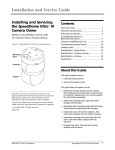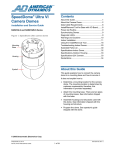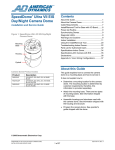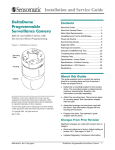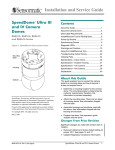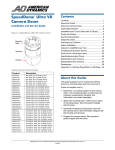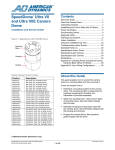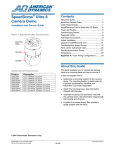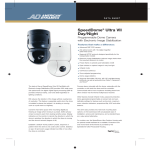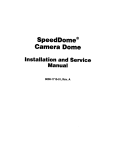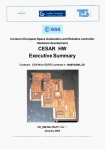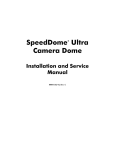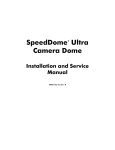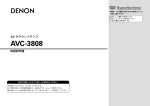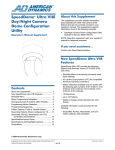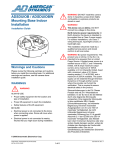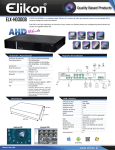Download American Dynamics AD716LS Specifications
Transcript
Installation and Service Guide DeltaDome II Programmable Surveillance Camera ™ Contents About this Guide.................................................... 1 About the Camera Dome ...................................... 2 Data Cable Requirements..................................... 8 AD716LS and AD715LS Series Install/Removal Tool for ADIOB Base ................... 8 Power-Up Routine ................................................. 9 Synchronizing Domes ........................................... 9 Figure 1. SpeedDome Ultra camera dome Diagnostic LEDs.................................................... 9 Warnings and Cautions....................................... 10 Indoor Installation ................................................ 12 Using the Install/Removal Tool ........................... 20 Mounting Base Troubleshooting Indoor Domes........................... 22 Ordering Parts ..................................................... 34 Specifications-Indoor Dome ................................ 36 Housing Specifications-Outdoor Housing.......................... 37 Specifications-22X Camera................................. 37 Declarations ........................................................ 38 About this Guide Eyeball This guide explains how to connect the camera dome to a mounting base and how to service it. It does not explain how to: • Determine a mounting location for the camera dome. The mounting location is determined by customer requirements; therefore, this information is provided separately. American Dynamics, DeltaDome, and the AD logo are registered trademarks of Sensormatic Electronics Corporation. Other product names (if any) mentioned herein may be trademarks or registered trademarks of other companies. • Attach the mounting base. There are two types of mounting bases. See information shipped with the base. No part of this guide may be reproduced in any form without written permission from Sensormatic Electronics Corporation. • Assemble housings and structures used with this dome. See information shipped with the housing and structure. (c) Copyright 2000. All rights reserved. MDR 6/00 • Program the dome. See operator's guide shipped with the dome. © Sensormatic 2000 (40 pages). 1 DeltaDome II Camera Dome 8000-2708-01, REV. B Housing and Eyeball Assembly About the Camera Dome The housing and eyeball assembly consists of the following: The DeltaDome II programmable surveillance camera (Figure 1) mounts indoors or outdoors, and can communicate with the video controller over a SensorNet 485, RS422, or Manchester network. The dome consists of a mounting base, and a housing and rotating eyeball assembly. • Housing. The housing contains the dome's power supply, pan motor, and electronics used to operate the eyeball. The housing provides one alarm input and one alarm output using the ADPTB base, or four alarm inputs and four alarm outputs using the ADIOB base. Mounting Base • Eyeball. Gloss black and 120mm (4.75") in diameter, the eyeball contains a camera, tilt motor, and associated electronics. The eyeball enables the camera to pan and tilt to track a target moving in any direction even as it moves under the dome. The housing and eyeball assembly connects to the base using a twist and lock action, which enables the dome to be easily moved from one location to another. The base attaches directly to a hard or tile ceiling, or indirectly to walls or ceilings using one of many optional housings and mounting structures. As shown in Figure 2, two base types are offered: an ADUPTB standard base and an ADIOB base with I/O board. Two slot covers in the eyeball facilitate access to the camera, one of which incorporates a camouflaged lens. Remove both covers to improve ventilation when the dome is to be used outdoors. • ADPTB Base. With this base, video, data, and power cables are inserted through the base and attached to the top of the housing and eyeball assembly, which is then connected to the base. A lanyard connects between the base and the housing and eyeball assembly to prevent cables from being pulled during disassembly. As shown in Table 1, the housing and eyeball assembly can be ordered: • With no base for existing indoor installations or for mounting outdoors. • With a ADPTB standard base or ADIOB base with I/O board for new indoor installations. • ADIOB Base. With this base, video, data, and power cables are pre-connected to an I/O PC board. A spring-finger connector on the board makes electrical contact with the housing and eyeball assembly as it connects to the base. • With one of four CCD cameras − Color NTSC − Black & White EIA − Color PAL − Black & White CCIR. Each camera has 22X optical zoom with continuous auto focus and back light compensation. Electronic zoom provides selectable magnification up to 176X. Table 1. Product codes for housing and eyeball assembly configurations Color NTSC B & W EIA Color PAL B & W CCIR AD716LS AD715LS AD716LS-1 AD715LS-1 RUPTB Base AD716LSP AD715LSP AD716LSP-1 AD715LSP-1 RUIOB Base AD716LSI AD715LSI AD716LSI-1 AD715LSI-1 No Base INSTALLATION AND SERVICE GUIDE 2 DeltaDome II Camera Dome 8000-2708-01, REV. B Indoor Ceiling Mounting Figure 2. Mounting base and housing and eyeball assembly ADPTB Mounting Base Using hardware shipped with the base, the dome attaches directly to indoor ceilings made of sheet rock, wood, metal, or concrete (Figure 3), or to tile ceiling T-bars where they intersect (Figure 4). ADIOB Mounting Base Figure 3. Surface mounting to hard ceilings Figure 4. Surface mounting to tile ceilings INSTALLATION AND SERVICE GUIDE 3 DeltaDome II Camera Dome 8000-2708-01, REV. B Indoor Ceiling/ Wall Mounting (Optional) Structural I-Beams RHIUIB† I-beam mount Enables dome to suspend from an Ibeam. The camera dome attaches to one of the following optional indoor mounting structures (Figure 5). Sheet Rock, Plaster or Wood Ceilings RHIUTH Tile Ceilings Top hat housing with trim ring This housing attaches to a ceiling or to most indoor mounting structures. A bubble and trim ring provide concealment. Optional bubbles: RUCLR (clear), RUSLV (silver), RUSMK (smoked), or RUGLD (gold). Plenum adapter RHPLA may be required to meet local fire codes. RHIUFB Fixed bracket Enables top hat housing to be recessed in a 2x2 tile (requires top hat RHIUTH). RHIUAB Adjustable bracket Enables top hat housing to be recessed in a 2x4 tile (requires top hat RHIUTH). RHIUHC Hard ceiling bracket Enables top hat housing to be recessed in ceiling (requires top hat RHIUTH). RHIU2X2* 2 X 2 tile mount Enables top hat housing to be recessed in 2x2 openings (incorporates top hat housing). RHIUFB* Fixed bracket Enables top hat housing to be recessed in ceiling (requires top hat RHIUTH). RHIU2X2P* 2 X 2 tile pendant mount Enables dome to be suspended from 2x2 openings. RHIUPNDT† Pendant mount Suspends dome from a hard ceiling. Wall Mounting RHIUWM* Wall mount Attaches dome to a flat vertical surface. 3 X 3 mounting plate Attaches dome to a standard 3.5 x 3.5 duplex electrical box. RHIUCM* Wall mount with corner feature Attaches dome to attach to a wall, inside corner, or outside corner. CAUTION: Do not use the same electrical box used for line voltage mains. RHIULWM*† Long .6m (24") wall mount Positions dome away from wall to enable it to see over furniture, shelving, and displays. This mounting structure attaches to the wall, inside corner, or outside corner. Electrical Box in Ceiling RHIU3X3† RHIU4X4† 4 X 4 mounting plate Attaches dome to a standard 4 x 4 duplex electrical box. CAUTION: Do not use the same electrical box used for line voltage mains. INSTALLATION AND SERVICE GUIDE * Option in white, but can be painted to match decor. † Top hat housing/dome assembly also mounts to structure. 4 DeltaDome II Camera Dome 8000-2708-01, REV. B Figure 5. Indoor mounting structures (optional) RHIUFB RHIUAB RHIUHC RHIU2X2 RHIUIB RHPLA RHIU2X2P RHIUTH RHIUWM RHIUPNDT RHIUCM RHIUTR RHIU3X3 RHIU4X4 RUCLR RUSLV RUSMK RUGLD INSTALLATION AND SERVICE GUIDE 5 RHIULWM DeltaDome II Camera Dome 8000-2708-01, REV. B Outdoor Mounting (Optional) SpeedDome Housing Adapter Bracket (Optional) Note: This document does not include outdoor installation and service instructions. For these instructions, see Installing the RHODUL Outdoor Housing, 8000-2573-04. An RHSDA adapter bracket (Figure 7) enables the dome to fit into SpeedDome indoor and outdoor housings. Locking pins in the bracket enable the dome to swing out for servicing or removal. The camera dome attaches to outdoor walls and ceilings using an RHODUL outdoor housing (Figure 6) and one of the following optional mounting structures (Figure 8): • RHORM Over Roof Mount • RHOCM Ceiling Mount • RHOPM Pole Mount • RHOWM Wall Mount • RH170 Corner Bracket. Figure 7. RHSDA adapter bracket (optional) The outdoor housing contains a pre-installed mounting base, a cooling fan for hot weather, a heater for cool weather and to prevent icing, and surge protection circuitry to protect against lightning strikes. An environmental PC board is used to pre-wire cables. A round spring-finger connector on the board makes electrical contact with the housing and eyeball assembly as it connects to the base. Note: Do not use the I/O board (designed for indoor use) in place of the environmental board. Figure 6. ADODH outdoor housing (optional) INSTALLATION AND SERVICE GUIDE 6 DeltaDome II Camera Dome 8000-2708-01, REV. B RHOPM pole mount Figure 8. Outdoor mounting structures (optional) RHORM over roof mount RHOWM wall mount RHOCM ceiling mount RH170 corner bracket (shown with RHOWM mount) Top View INSTALLATION AND SERVICE GUIDE 7 DeltaDome II Camera Dome 8000-2708-01, REV. B Data Cable Requirements Install/Removal Tool for RUIOB Base Table 2 shows the data cable requirements for SensorNet, RS422, and Manchester networks. For more information about communication protocols and cable networks, see Communication Protocols and Cable Networks, 8000-2573-19. The install/removal tool (Figure 9) enables you to connect or disconnect the housing and eyeball assembly from the RUIOB base with I/O board, and to attach/detach skirts and bubbles to a top hat housing, without the need for a ladder. The tool attaches to a telescopic pole (purchased separately). See page 20. Table 2. Data cable requirements SensorNet RS422 Manchester 1 unshielded, twisted pair* 2 shielded, twisted pair* 1 shielded twisted pair** Wire gauge 22 AWG 22 AWG 18 AWG Con nection Nonpolarized Polarized Polarized Max. devices on line 32 10 Cable type * CAUTION: Do not use this tool to connect the dome the RUPTB base. Figure 9. RHIRT indoor install/removal tool RHIRT Removal Tool 3 Teslescopic Pole 08140 by Recreational Water Products. See page 20 to order. Power, data, and video cables can be ordered separately or within a composite cable that can be ordered in various lengths. Plenum-rated cables must be used in indoor ceilings used for environmental air return (called "other air space" in the National Electrical Code). Order parts through your distribution network. Note: If you order cable from an outside source, wire colors may be different. ** Belden 88760 (plenum), or Belden 8760 cable (non-plenum) cable is recommended. Plenumrated cables must be used in indoor ceilings used for environmental air return (called "other air space" in the National Electrical Code). Order cable directly from Belden by calling 1-800-235-3361. INSTALLATION AND SERVICE GUIDE 8 DeltaDome II Camera Dome 8000-2708-01, REV. B Power-Up Routine Synchronizing Domes After power is connected to the dome, the dome performs the following homing routine. To prevent picture rolling when switching from camera to camera, all domes can be synchronized to a 50Hz or 60Hz ac source. A V-phase adjustment at the control console enables the dome to sync to any line phase. 1. After a few seconds, the camera lens tilts up into the housing and eyeball assembly. 2. The lens tilts downs until it looks at the floor. 3. Eyeball pans slowly. Diagnostic LEDs 4. Lens tilts up 90° (home position). Once the lens is in its home position, you can then use the controller to call up the camera and control it. If ADPTB standard base is used, LEDs in the housing and eyeball assembly enable you to check for power and data. If ADIOB base with I/O board is used, LEDs on the underside of the mounting base enable you to check for power and data. If an RS422 network is used, other LEDs on the board indicate that wiring is correct, reversed, open, or grounded. INSTALLATION AND SERVICE GUIDE 9 DeltaDome II Camera Dome 8000-2708-01, REV. B Warnings and Cautions WARNING! EU power requirements: This product runs on 24Vac. In the EU, it is intended to be powered from a Limited Power Source. A limited power source is a certified source of SELV, and if inherently limited, with 8 amps maximum output current, and a maximum of 100VA available; or if not inherently limited, fused with a maximum value of 3.3 Amps, meeting section 2.11 of IEC950, and a maximum of 250VA available. The power supply can be obtained through Sensormatic or through another source where the provider can furnish the verification. This is required to assure electrical safety in the product. Please review the following warnings and cautions before you begin installation or service. WARNINGS WARNING! ALWAYS USE: • Proper safety equipment for the location and type of installation. • Proper lift equipment to reach the installation. Stromanforderungen in der EU: Dieses Produkt wird mit 24 V Wechselstrom betrieben. In der EU ist es für den Betrieb durch eine begrenzte Stromquelle vorgesehen. Eine begrenzte Stromquelle ist eine zertifizierte SELV-Quelle (Schutzkleinspannung), bei inhärenter Begrenzung mit einem maximalen Ausgangsstrom von 8 A und 100 VA maximaler Verfügbarkeit, bei nicht inhärenter Begrenzung mit einer maximalen Sicherung von 3,3 A gemäß Abschnitt 2.11 der IEC950 und 250 VA maximaler Verfügbarkeit. Das Netzteil kann über Sensormatic oder eine andere Quelle bezogen werden, wobei der Anbieter den Nachweis der Konformität bereitstellen sollte. Dies ist zur Gewährleistung der elektrischen Sicherheit des Produktes erforderlich. • Safety features of the lift equipment. BE SURE: • Electrical power is not connected to the dome when connecting wires. Dome will move when power is applied. • Electrical power is not connected to nearby fixtures that you might touch during installation. WARNING! DO NOT install this camera dome in hazardous areas where highly combustible or explosive products are stored or used. WARNING! This dome runs on 24Vac. DO NOT connect line voltage to this dome. North America power requirements: In North America, this device is intended to be supplied from a Class 2 power supply. For outdoor installations, use Class 3 wiring techniques, liquidtight conduit, or liquid-tight pipe. This installation should be made by a qualified service person and should conform to all local codes. INSTALLATION AND SERVICE GUIDE 10 DeltaDome II Camera Dome 8000-2708-01, REV. B CAUTIONS G G When connecting the housing and eyeball assembly to an outdoor housing: For indoor domes, the maximum length of power cable allowed between the Class 2 LPS (low voltage) ac source, such as a J-box, and the dome is 250m (820'). − Remove both slot covers to keep the camera from overheating. G Do not run data and power cables adjacent to or in the same conduit as line voltage mains power. − Place tubing around the BNC connectors to avoid shorting their metal surface to the outdoor housing. G SensorNet 485 networks require 22 AWG unshielded cable. Do not exceed 32 devices per cable run. − Check heater fans. Both fans must be on to prevent overheating. G RS422 networks require 22 AWG shielded cable. Do not exceed 10 devices per cable run. G Manchester networks require 18 AWG shielded cable. Do not exceed 3 devices per cable run. G Always terminate the camera dome connected at the end of a cable run. G When using the RUPTB standard base and wiring cables directly to the dome, ALWAYS connect the video cable to the dome before you connect the 9-pin cable (which contains power). If you connect the 9-pin cable first, you risk shorting delicate electronics near the connector. G I/O PC board (when used). − Keep cables entering the housing away from the heater assembly. Note: For further information, see installation instructions shipped with the outdoor housing. G If disassembling the dome: − Dome contains electrostatic-sensitive devices! Use a ground strap when handling PC boards. − Once disassembled, parts of housing and eyeball assembly are "extremely fragile" and may break. Proceed using extreme care! − If a cable clamp is on this board, remove it, as it could damage cable connectors in the housing during assembly. − Use a jeweler's 2.5mm (0.1") slotted screwdriver to tighten connector screws. Do not over tighten these screws. − Use the dust cover when shipping the I/O board back to the manufacturer. It will protect the spring-finger connector. INSTALLATION AND SERVICE GUIDE 11 DeltaDome II Camera Dome 8000-2708-01, REV. B Other Preparations Indoor Installation To ensure a smooth and successful installation, you must: This section explains how to connect the housing and eyeball assembly to a: G Have electrical work comply with latest national electrical code, national fire code, and all applicable local codes and ordinances. Items You Will Need G Coordinate work with other trades to avoid interference. You should have on hand the following tools and parts: G Verify existing site conditions and coordinate with the owner's representative and appropriate utilities as required. G Obtain copies of all related plans, specifications, shop drawings and addenda to schedule and coordinate related work. G Thoroughly review the project to ensure that all work meets or exceeds the above requirements. Bring alleged discrepancies to the attention of the CCTV Project Coordinator. • ADPTB mounting base • ADIOB mounting base. G G Install/Removal tool to attach and detach domes and bubbles without a ladder from RUIOB mounting bases. Base kit: − ADIOB (base with I/O board), or − ADPTB (standard base). G Housing and eyeball assembly, 0100-2283-XX. The -XX determines the type of camera used. -25 = Color NTSC -26 = Color PAL -27 = Black and White EIA -28 = Black and White CCIR INSTALLATION AND SERVICE GUIDE 12 DeltaDome II Camera Dome 8000-2708-01, REV. B Connecting to ADPTB Mounting Base 2. Attach safety lanyard to cap on housing and eyeball assembly (Figure 11). Use M3 x 6 screw supplied with lanyard. This procedure explains how to connect the housing and eyeball assembly to a ADPTB base. Figure 11. Attaching safety lanyard CAUTION: The maximum length of cable allowed between the Class 2 LPS (low voltage) ac source, such as a J-box, and the dome is 250m (820'). WARNING! Ensure that ac power and electrical signals are off during wire connections! 1. Set dome address (Figure 10). Recessed at top of housing and eyeball assembly are three rotary address switches. Address range is from 001 to 255, except for Manchester, which is 01 to 64. Set switches from most significant bit (MSB) to least significant bit (LSB). For example: For address 166, set SW3 to 1, SW2 to 6, and SW1 to 6. Only use this location to secure lanyard. Figure 10. Setting address switches SW3 MSB 0 SW2 9 0 SW1 LSB 9 0 9 INSTALLATION AND SERVICE GUIDE 13 DeltaDome II Camera Dome 8000-2708-01, REV. B 3. WITH POWER OFF, connect video cable (Figure 12). 5. Connect 9-pin plug (data and power) to 9-pin receptacle (Figure 13). a. Connect BNC of video micro coax cable 6003-0131-01 to BNC of video cable. CAUTION: DO NOT connect 9-pin plug unless you have performed step 3 first! b. Feed cable through access hole in base. c. Press micro coax connector into mating receptacle in top of housing and eyeball assembly. A firm snap indicates a tight connection. a. Feed cables through access hole in base. b. Connect data and power wires to 9-pin plug (refer to charts below). c. Insert plug into mating receptacle in top of housing and eyeball assembly. 4. If dome is connected at end of comm. line, set termination jumper JW1 (Figure 12). Manchester data and power connections (Ultra IV only). Order data cable 88760 (plenum) or 8760 (non-plenum) from Belden by calling 1-800-235-3361. Jumper JW1 is pre-installed across pins 1-2 (unterminated). These pins are closest to 9-pin connector. If dome is to be connected at end of a communications line, place jumper across pins 2-3 (terminated). You may need a small slotted screwdriver to gently pry jumper loose. Be careful not to damage underlying PC board. Figure 12. Video cable connection and termination jumper location Pin Color Designation 1 White Manchester (–) 2 Black Manchester (+) 3 Black 24Vac 4 Red Ground 5 White 6-9 — 24vac Not used. RS422 data and power connections Micro Coax Cable Termination Jumper JW1 Pin Color Designation 1-2 — 3 Black 24Vac 4 Red Ground 5 White 24Vac 6 Orange RS422 Data In High (+) 7 Green RS422 Data In Low (–) 8 Yellow RS422 Data Out High (+) 9 Brown RS422 Data Out Low (–) Not used. SensorNet data and power connections INSTALLATION AND SERVICE GUIDE 14 Pin Color Designation 1 Orange SensorNet (unshielded) 2 Yellow SensorNet (unshielded) 3 Black 24Vac 4 Red Ground 5 White 24Vac 6-9 — Not used. DeltaDome II Camera Dome 8000-2708-01, REV. B 6. Connect 4-pin plug (alarm input/output) to 4-pin receptacle (Figure 13). 7. Check LEDs to verify that power and data are reaching dome (Figure 13). a. Feed cable through access hole in base. LEDs CR2, CR3, and CR4 surround video connection and are visible through opening. LEDs light in the following order: b. Connect alarm wires to 4-pin plug (refer to chart below). c. Insert plug into mating receptacle in top of housing and eyeball assembly. To test Manchester network: a. Yellow CR4 LED glows steadily indicating communication between controller and dome, or glows steadily, turns off, and then blinks. Alarm connections Pin Color Designation 1 — +12Vdc 2 — Alarm Out 3 — Alarm In 4 — Common Note: CR4 only blinks when both Manchester wires are connected. Green CR2 LED is not used to test Manchester. b. Red CR3 LED blinks slowly indicating that dome software is operating. Figure 13. Cable connections (Manchester requires separate cables for data and power) To test SensorNet or RS422 network: a. Green CR2 LED blinks indicating data present. Yellow CR4 LED glows steadily indicating communication between controller and dome (RS422), or glows steadily, turns off, and then blinks (SensorNet). Note: To check RS422 connections, set dome address switch SW3 to 9 and check red and green LEDs. Red should be off, green should blink. If red blinks, RS422 is wired backwards. If red and green are off, then RS422 communication is absent. When done with this test, set switch SW3 back to 0 and reset dome from controller. 9-pin plug LEDs CR2, CR3, and CR4 visible through opening. 4-pin plug b. Red CR3 LED blinks slowly indicating that dome software is operating. INSTALLATION AND SERVICE GUIDE 15 DeltaDome II Camera Dome 8000-2708-01, REV. B 8. Connect housing and eyeball assembly to base (Figure 14). 9. Wait a few seconds for dome to begin its homing routine. Homing routine indicates that address was placed into dome memory and that dome is ready for programming. a. Align dimple on cap of dome with rib on mounting base. b. Mate housing and eyeball assembly to base and turn it clockwise until you hear a click. Figure 14. Connecting housing and eyeball assembly to base (cables and lanyard not shown) LA TC H INSTALLATION AND SERVICE GUIDE 16 DeltaDome II Camera Dome 8000-2708-01, REV. B Connecting to ADIOB Mounting Base RS422 data connections This procedure explains how to connect the housing and eyeball assembly to an ADIOB mounting base. CAUTION: The maximum length of cable allowed between the Class 2 LPS (low voltage) ac source, such as a J-box, and the dome is 250m (820'). WARNING! Ensure that ac power and electrical signals are off during wire connections! Pin Color 1 Orange RS422 Data In High (+) Designation 2 Green RS422 Data In Low (–) 3 Yellow RS422 Data Out High (+) 4 Brown RS422 Data Out Low (–) 5-6 — Not used. SensorNet data connections Referring to Figure 15: CAUTION: Detach and discard cable clamp if I/O board has one. If not removed, clamp can damage 9-pin connector in housing and eyeball assembly when you attempt to connect it to base. Pin Color Designation 1-4 — 5 Orange SensorNet (unshielded) 6 Yellow SensorNet (unshielded) Not used. Figure 15. Electrical connections 1. Set data communications jumper JW1. If data lines continue to another dome, set JW1 across pins 1-2 (unterminated). Otherwise, set JW1 across pins 2-3 (terminated). 2. Connect video cable to BNC connector P8 on I/O board. 3. Connect Manchester, RS422, or SensorNet 485 data wires to connector P1. Manchester data connections (Ultra IV only). Order data cable 88760 (plenum) or 8760 (non-plenum) from Belden by calling 1-800-235-3361. Pin Color 1-4 — 5 Black Manchester (+) 6 White Manchester (–) Pin 1 Designation Not used. Pin 1 Pin 1 P3 P7 P4 P8 I/O BOARD Pin 1 P1 1 JW1 JW1 Terminations INSTALLATION AND SERVICE GUIDE 17 PINS FUNCTION 1-2 Unterminated 2-3 Terminated DeltaDome II Camera Dome 8000-2708-01, REV. B 4. Connect alarm output cable, if used, to P3 connector. Pin Color 1 — 12Vdc (100mA max.) 2 — 12Vdc (100mA max.) 3 — Output P0 (40mA sync. max.) 4 — Output P1 (40mA sync. max.) 5 — Output P2 (40mA sync. max.) 6 — Output P3 (40mA sync. max.) 7 — Ground 8 — Ground 7. Reattach I/O board. 8. Connect power to base. Designation 9. Check LEDs on I/O board to verify power and data are reaching dome (Figure 16). a. Observe green (ac power) and yellow (comm.) LEDs. Green LED glows steadily and yellow LED glows steadily (RS422, Manchester) or blinks (SensorNet). b. For RS422, press and hold data test switch SW1 and observe nearby red and green LEDs; they indicate the following: 5. Connect alarm input cable, if used, to P4 connector. Designation Constant green, Blinking red RS422 line correctly wired. Constant green, No red RS422 "Data In -" shorted to ground. Constant red, Blinking green "Data In +/ -" wires reversed. Pin Color 1 — Alarm 3 input (3.5mA sink) 2 — Alarm 2 input (3.5mA sink) Blinking red, Green off "Data In +" shorted to ground. 3 — Alarm 1 input (3.5mA sink) Both LEDs off 4 — Alarm 0 input (3.5mA sink) "Data In +/ -" wires shorted or open. 5 — Ground 6 — Ground Figure 16. Test switch/LEDs on I/O board 6. Connect power to P7 connector. Pin Color Designation 1 Black 24 Vac 2 Red Ground 3 White 24 Vac SW1 RS422 Test Pushbutton Comm. LED Power LED INSTALLATION AND SERVICE GUIDE 18 DeltaDome II Camera Dome 8000-2708-01, REV. B 11. Connect housing and eyeball assembly to base (Figure 18). 10. Set dome address (Figure 17). Recessed at top of housing and eyeball assembly are three rotary address switches. Address range is from 001 to 255, except for Manchester, which is 01 to 64. a. Align dimple on cap of dome with rib on mounting base. b. Mate housing and eyeball assembly to base and turn it clockwise until you hear a click. Set switches from most significant bit (MSB) to least significant bit (LSB). For example: For address 166, set SW3 to 1, SW2 to 6, and SW1 to 6. 12. Wait a few seconds for dome to begin its homing routine. Homing routine indicates that address was placed into dome memory and that dome is ready for programming. Figure 17. Setting address switches SW3 MSB 0 SW2 9 0 Figure 18. Connecting housing and eyeball assembly to base SW1 LSB 9 0 9 L A TC H INSTALLATION AND SERVICE GUIDE 19 DeltaDome II Camera Dome 8000-2708-01, REV. B TO CONNECT DOME: Using the Install/Removal Tool 1. Insert dome "eyeball down" into tool's receptacle. Fins on dome mate with slots in tool. Use fins to properly align dimple at top of dome with label on tool. CAUTION: Do not use this tool to connect the dome the ADPTB base. 2. Align label on tool with logo on I/O board in base. Push dome up into place. Used only when the dome is connected to a base having an I/O board, the RHIRT install/removal tool eliminates the need for a ladder during routine service. The tool can be used to: 3. Turn dome clockwise until it clicks. 4. If power is applied, dome should begin its "homing" routine. • Detach skirt or bubble from housing, if used. Skirt or bubble remain attached to the housing during service. 5. Lower pole. • Connect/Disconnect dome from ADIOB base. TO DISCONNECT DOME: • Reattach skirt or bubble. 4. Raise pole and insert dome "eyeball down" into tool's receptacle. Telescopic Pole Required to Use Tool 5. Fins on dome mate with slots in tool. The tool attaches to a telescopic pole similar to the type used to clean swimming pools. The pole should be 5 feet, 5 inches to 15 feet, 5 inches long and have a 1.170 inch inside diameter to accept the 1.125 inch diameter stem of the tool. If this pole cannot be obtained locally, contact the following manufacturer: 6. Turn dome counterclockwise until it unlocks. 7. Lower pole "vertically" to prevent camera dome from falling out. CAUTION: Turning pole horizontally as it is lowered can cause camera dome to fall out of tool and possibly break on floor. Recreational Water Products 627 E. College Ave. Decatur, GA 33030 Ask for product code 08140 UPC: 0-14746-58140-2 8. Remove dome for service. Procedure Referring to Figure 19, maneuver the stem of the tool into the top of the pole until it snaps in place. TO ATTACH SKIRT OR BUBBLE: Use tool to push up on bubble and to secure it in place. Magnets secure the bubble. Lower pole. TO DETACH SKIRT OR BUBBLE: Lifting pole up at an angle, use one of the hooks on tool to catch one of the notches at side of dome and pull down. T-lanyard will prevent skirt or bubble from falling. INSTALLATION AND SERVICE GUIDE 20 DeltaDome II Camera Dome 8000-2708-01, REV. B Figure 19. How to use the install/removal tool Skirt or Bubble Attachment/Detachment A B Catch notch and pull down. C Snap tool into pole. Attachment Detachment Dome Connection (reverse steps to disconnect) Line up Line up D Turn until you feel a click. B C E Do not use this tool to connect the ADPTB base! INSTALLATION AND SERVICE GUIDE 21 DeltaDome II Camera Dome 8000-2708-01, REV. B Items You Will Need Troubleshooting Indoor Domes You should have on hand the following items: CAUTION: This troubleshooting section is for indoor camera domes only! To troubleshoot outdoor domes, see installation and service manual shipped with the outdoor housing. G Phillips-head screwdriver G Small slotted screwdriver G 2.5mm (0.1") slotted screwdriver (for wire connections). Wider blade widths can damage connectors. G Socket wrench with 5" extension and 5.5mm, 6mm, 8mm, and 10mm sockets G 14-18 AWG and 20-22 AWG wire strippers G Install/Removal tool to connect/disconnect dome to indoor bases with I/O boards, and to attach/detach skirts and bubbles-without a ladder. This chapter contains information on: • Routine troubleshooting • Detailed troubleshooting • Disassembling the dome. IMPORTANT! 1. Try routine troubleshooting first! Use this procedure to isolate the problem without disassembling the housing and eyeball assembly (ADIOB base is field repairable). CAUTION: DO NOT troubleshoot if the dome functions but does not pan or tilt (see step 2). 2. If you cannot isolate the problem, or the dome functions but does not pan or tilt, ship the dome to the National Service Center (NSC). The manufacturer suggests that you ship the entire dome (with base, if it contains an I/O board) to the NSC. For repair authorization, call: 1-800-543-9740 (CEs) 1-800-442-2225 (Dealers) 1-800-241-6678 (End Users). 3. If you have no choice but to repair the housing and eyeball assembly. Follow the detailed troubleshooting procedure, but use extreme care. CAUTION: Once disassembled, parts of the housing and eyeball assembly are "extremely fragile" and may break. Proceed using extreme care! INSTALLATION AND SERVICE GUIDE 22 DeltaDome II Camera Dome 8000-2708-01, REV. B Routine Troubleshooting Procedure Use this procedure if: Follow steps until the problem is corrected. • Dome does not respond to commands 1. Check video on monitor (a, b, or c). • Dome does not produce video a. No video? Go to step 2. • Quality of the video is poor b. Contrast or color off? • Dome has no lens control. YES Ship entire dome (base included, if it contains an I/O board) back to the NSC. Place dust cover over spring finger connector on I/O board. CAUTION: • DO NOT use this procedure if the dome functions but does not pan or tilt (see page 22). NO • If an I/O board is used, use a ground strap when handling the board. Go to step 2. c. Video rolls when switching between monitors? • When shipping a base having an I/O board to the manufacturer, place the dust cover over the spring finger connector to protect it. YES Use video controller or switcher to synchronize video vertical sync phases of all domes to ac line. For specific instructions, see installation and service manual for controller or switcher. • DO NOT overtighten connector screws on the I/O board; they are delicate. Use a 2.5mm (0.1") slotted screwdriver. Wider blade widths can damage connectors. NO Go to step 2. 2. Check ac power and video connections at Jbox. Are 24Vac and/or video signal absent? YES Correct problem at J-box. NO Go to step 3. 3. Detach dome from base and examine address switches. Are they set correctly? YES If dome still doesn't respond, ship entire dome (base included, if it contains an I/O board) to the NSC. If you must repair the dome, see "Detailed Troubleshooting", next. NO Set correct address and reattach housing and eyeball assembly. Steps 4-9 are only for bases with I/O boards! If the mounting base DOES NOT contain an I/O board, stop here and ship the housing and eyeball assembly to the NSC. See "IMPORTANT!" on page 22 for phone numbers. INSTALLATION AND SERVICE GUIDE 23 DeltaDome II Camera Dome 8000-2708-01, REV. B 4. Isolate problem to housing and eyeball assembly or base by attaching dome to another base with I/O board. Does dome display video or respond to commands? 6. Observe green power LED on I/O board (Figure 21). Is green LED off or not on steady? YES Verify 24Vac cable is properly attached. If O.K., replace I/O board or ship entire dome to the NSC. YES Problem is likely cable connections or I/O board if used. Go to step 5. NO NO Ship dome and base to NSC. Place dust cover over spring finger connector on I/O board. P7 Connector (AC in) Pin Color Designation 1 Black 24 Vac 2 Red Ground 3 White 24 Vac 5. Verify coaxial video cable is securely connected to coax of I/O board (Figure 20). Is cable disconnected? YES Connect cable. NO Go to step 7. Go to step 6. 7. Observe yellow communication LED on I/O board (Figure 21). Is yellow LED flashing? Figure 20. I/O board connector and jumper locations YES Go to step 8. NO Verify cable is properly attached by referring to table in step 10, page 18. If OK, replace I/O board or ship dome and base to NSC. Figure 21. I/O board switch and LED locations SW1 RS422 Test Pushbutton Pin 1 Pin 1 Comm. LED Pin 1 Power LED P3 P7 P8 I/O BOARD P4 Pin 1 P1 1 JW1 JW1 Terminations PINS FUNCTION 1-2 Unterminated 2-3 Terminated INSTALLATION AND SERVICE GUIDE 24 DeltaDome II Camera Dome 8000-2708-01, REV. B P1 connector (Manchester data) Pin Color 1-4 9. Check spring finger connector on I/O board by connecting housing and eyeball assembly to original base to verify contact between spring fingers and CPU board (under cap). Does dome produce video and respond to commands? Designation Not used. 5 Black Manchester (+) 6 White Manchester (–) YES Spring fingers may not have seated properly. Reconnect housing and eyeball assembly. P1 connector (RS422 data) Pin Color 1 Orange RS422 Data In High (+) 2 Green RS422 Data In Low (–) 3 Yellow RS422 Data Out High (+) 4 Brown S422 Data Out Low (–) 5-6 — NO Replace I/O board. Designation If routine troubleshooting did not solve the problem, the manufacturer strongly recommends you ship the entire dome (including base, if an I/O board is used) to the National Service Center (NSC) for service. See page 22 for phone numbers. If you must perform detailed troubleshooting, use extreme care when disassembling parts! See "Detailed Troubleshooting," next. Not used. P1 connector (SensorNet 485 data) Pin Color Designation 1-4 — Not used. 5 Orange SensorNet 485 6 Yellow SensorNet 485 8. If using RS422 network and an I/O board is used, check comm. line connections by pressing and holding data test switch SW1 (Figure 21) and observing nearby red and green LEDs. These LEDs indicate the following: Constant green, Blinking red Comm. line correctly wired. Constant green, No red "Data In -" shorted to ground. Constant red, Blinking green "Data In +/ -" wires reversed. Blinking red, Green off "Data In +" shorted to ground. Both LEDs off "Data In +/ -" wires shorted or open. INSTALLATION AND SERVICE GUIDE 25 DeltaDome II Camera Dome 8000-2708-01, REV. B Detailed Troubleshooting Procedure Use this procedure to determine if the problem is a simple cable connection or a major component. 1. Match symptom to one of the following criteria: − Dome functions but does not pan To perform this procedure, you must open the housing and eyeball assembly. Refer to "Disassembling the Dome" on page 27. − Dome functions but does not tilt − Dome does not "home" or respond to commands even when attached to another dome's base and its address switches are set correctly (dead dome). CAUTION: • DO NOT use this procedure if the dome functions but does not pan or tilt (see page 22). 2. Choose a, b, or c to determine if problem is a cable connection or major component. • If routine troubleshooting did not solve the problem, the manufacturer strongly recommends you ship the entire dome (including base, if an I/O board is used) to the National Service Center (NSC) for service. If you must perform detailed troubleshooting, use extreme care when disassembling parts! a. Dome functions but does not pan. On CPU board, is pan motor ribbon cable attached to connector P4 and is metal side of its fingers towards contacts of connector? YES Replace CPU board. If this doesn't work, replace pan motor. • When shipping a base with I/O board back to the NSC, place the dust cover over the spring fingers to protect them. NO Connect cable(s). b. Dome functions but does not tilt. • Delicate connector screws on I/O board. DO NOT over tighten them! Use a 2.5mm (0.1") slotted screwdriver. Wider blade widths can damage connectors. On camera/lens board, is tilt motor cable attached to connector J3? Is slip ring cable attached to connector J2? YES Replace camera/lens board. If this doesn't work, replace tilt motor. • Dome contains electrostatic-sensitive PC boards. Use a ground strap when handling boards. NO Connect cable(s). c. Dome does not "home" or respond to commands (dead dome). On CPU board, is power supply cable attached to connector P3? Is slip ring cable attached to connector P2? YES Replace CPU board. If this doesn't work, replace power supply board. NO INSTALLATION AND SERVICE GUIDE 26 Connect cable(s). DeltaDome II Camera Dome 8000-2708-01, REV. B Disassembling the Dome Removing the CPU Board This section explains how to remove the following parts from the camera dome. Referring to Figure 22. 1. Remove cap. • CPU board, page 27 Remove three Phillips-head screws holding cap, then "gently" lift cap to one side. • Power supply, page 28 • Pan motor, page 28 2. Detach connectors. • Slot covers, page 29 On CPU board, detach 8-pin power supply cable from connector P1, pan motor cable from connector P8, and 14-pin slip ring cable from connector P2. • Camera, page 29 • Eyeball, page 30 • Camera/Lens board, page 30 3. Remove CPU board. • Tilt motor, page 31. Push your finger through large finger connector hole in cap to pop out CPU board. CAUTION: Once disassembled, parts of dome housing and eyeball assembly are "extremely fragile" and may break. Proceed using extreme care! CAUTION: Electrostatic-sensitive device. Use a ground strap when handling CPU board. 4. Reverse steps to reassemble. This section also explains how to update and reprogram dome software (Page 33). CAUTION: Do not to pinch wires! When inserting CPU board into housing, avoid pinching power supply cable wires against standoffs. To order parts, see page 34. Tools Required • Phillips-head screwdriver. Figure 22. Removing the CPU board • Small slotted screwdriver. P2 P8 P1 Metal fingers of ribbon cable must face contacts of connector. INSTALLATION AND SERVICE GUIDE 27 DeltaDome II Camera Dome 8000-2708-01, REV. B Removing the P/S Board Removing the Pan Motor Referring to Figure 23. Referring to Figure 24. 1. Perform procedure "Removing the CPU Board" (this page). 1. Perform procedure "Removing the CPU Board" (page 27). 2. Remove metal shield. 2. Perform procedure "Removing the P/S Board" (page 28). Remove three standoffs holding metal shield, gently remove power supply cable grommet from shield, then "gently" lift shield out of housing. 3. Remove pan motor. Lift motor housing up as shown (1) to disengage motor from pan gear. Then pull motor bracket towards outside of housing (2) to remove. CAUTION: Do not pull delicate cables attached to power supply board. 4. Reverse steps to reassemble. 3. Detach fan motor cable. CAUTION: When putting in a new motor, be careful to properly mesh motor and pan gears! Failure to do so can destroy both motor and pan gear. Verify pan gear turns freely! Cable connects to connector CN3 on power supply board. 4. Remove power supply board. Remove three standoffs, then remove power supply board from housing. Figure 24. Removing the pan motor CAUTION: Electrostatic-sensitive device. Use a ground strap when handling power supply board. Pan Motor (lift up, then out) 5. Reverse steps to reassemble. 1 2 Figure 23. Removing the P/S board INSTALLATION AND SERVICE GUIDE 28 DeltaDome II Camera Dome 8000-2708-01, REV. B Removing the Slot Covers Removing the Camera 1. Gently swivel eyeball to totally expose one of two slot covers (Figure 25). 1. Perform procedure "Removing the Slot Covers" (page 29). CAUTION: Swiveling fast can damage gears. 2. Remove ribbon cable from camera (Figure 22). Swivel camera yoke to expose camera connector. Then, using a small slotted screwdriver, 1) gently pry camera connector loose from camera, and 2) pull it down through cable tie wrap. 2. Insert small, thin-bladed screwdriver into space between cover and eyeball. 3. Gently pry off slot cover. 4. Gently swivel eyeball to totally expose remaining slot cover. With other cover removed, this cover can be easily removed. Figure 26. Removing the ribbon cable Figure 25. Removing slot covers 1 2 3. Remove camera (Figure 27). 1) Loosen the screw holding the camera tripod mount, then 2) carefully lift the camera out. Figure 27. Removing the camera 2 1 Reverse steps to reassemble. Ensure ribbon cable pins are inserted "face down". INSTALLATION AND SERVICE GUIDE 29 DeltaDome II Camera Dome 8000-2708-01, REV. B Detaching the Eyeball Removing the Camera/Lens Board 1. Perform procedure "Removing the Slot Covers" (page 29). 1. Perform procedure "Removing the Slot Covers" (page 29). 2. Perform procedure "Removing the Camera" (this page). 2. Perform procedure "Removing the Camera" (page 29). 3. Detach eyeball from housing (Figure 28). 3. Perform procedure "Detaching the Eyeball" (page 30). a. Turn yoke to access tabs. One tab is more accessible than the other. Use your finger to press this tab while, simultaneously, using a small slotted screwdriver to press the other. 4. Separate yoke brackets (Figure 30). Figure 30. Separating the yoke brackets b. While pressing tabs, push up on eyeball to detach it. Figure 28. Loosening the eyeball 5. Gently pry off yoke bracket covering camera/lens board to access bearing assembly (Figure 31). Figure 31. Removing the yoke brackets 4. Detach slip ring connector (Figure 29). Figure 29. Detaching the eyeball INSTALLATION AND SERVICE GUIDE 30 DeltaDome II Camera Dome 8000-2708-01, REV. B The following steps refer to Figure 32. Removing the Tilt Motor 6. Access camera/lens board. 1. Perform procedure "Removing the Slot Covers" (page 29). To do this, loosen captive retaining screw holding bearing assembly in place and remove this assembly. 2. Perform procedure "Removing the Camera" (page 29). 7. Remove cables from camera/lens board. 3. Perform procedure "Detaching the Eyeball" (page 30). a. Small amber ribbon cable is from tilt motor. Unplug this cable from connector J3 on camera/lens board. 4. Separate yoke brackets (Figure 33). b. Large gray ribbon cable is from slip ring connector. Unplug this cable from connector J2 on camera/lens board. Figure 33. Separating the yoke brackets DO NOT unplug small white ribbon cable from connector J1. 8. Push out on three prongs to detach camera/lens board. 9. Reverse steps to reassemble. Figure 32. Removing the camera/lens board Prongs (3) DO NOT unplug cable from J1. J3 (Pins on ribbon cable must face contacts on connector.) 5. Gently pry off yoke bracket covering pan gear assembly to access tilt cable assembly (Figure 34). Figure 34. Removing the yoke brackets Camera/Lens Board Bearing Assembly INSTALLATION AND SERVICE GUIDE 31 DeltaDome II Camera Dome 8000-2708-01, REV. B 8. Reverse steps to reassemble. 6. Access tilt motor. To do this, loosen captive retaining screw holding tilt cable assembly in place and gently remove this assembly. CAUTION: When installing a new motor, be careful to properly mesh motor and tilt gears! Failure to do so can destroy both motor and tilt gear. Verify tilt gear turns freely! 7. Remove tilt motor (Figure 35). Lift motor housing up as shown (1) to disengage motor from tilt gear. Then pull motor bracket towards outside of cable/tilt assembly (2) to remove motor. Figure 35. Removing the tilt motor Tilt Motor (Lift up, then out.) INSTALLATION AND SERVICE GUIDE 32 DeltaDome II Camera Dome 8000-2708-01, REV. B Updating/Reprogramming Dome Software Figure 36. Removing the flash memory chip To update or reprogram dome software: 1. Remove flash memory chip. Insert chip extractor tool into square access hole and squeeze to extract flash memory chip (Figure 36). CAUTION: Electrostatic-sensitive device. Use a ground strap when handling chip. 2. Reprogram chip or replace it with new chip. 3. Reinsert chip. Align dot on chip with indent on socket, then push down on chip to reinsert it. INSTALLATION AND SERVICE GUIDE 33 DeltaDome II Camera Dome 8000-2708-01, REV. B Ordering Parts 20 Standoff, M3x6Hx19L (Qty. 3) 5887-1122-020 21 Power Supply PC Board 5606-0015-01 This section helps you to identify parts that make up the base and housing and eyeball assembly. Parts in Table 3 are shown in Figure 37. 22 Slip Ring Assy. 2100-0005-01 23 Pan Motor 3501-0017-01 0500-7255-02 24 Housing Order parts through your parts distribution network. 25 Bearing Assy., Pan Gear 2510-0040-01 Table 3. Parts list 26 Skirt 0500-6710-01 27 Tilt Motor 3501-0018-01 1 Mounting Base 0400-1146-01 28 Slot Cover (No Lens)* 0500-8037-01 2 Video Cable Adapter, BNC to Micro 6003-0131-01 29 Yoke, Camera 0500-7258-01 30 Camera/Lens PC Board 0301-0953-01 3 Plug, 4-Pin 2109-0572-04 31 Bearing Assy., Lens Carriage 2510-0038-01 4 Plug, 9-Pin 2109-0572-09 32 Yoke Bracket (Qty. 2) 0500-8038-01 5 Lanyard 0500-8019-01 33 Cable Assy., Tilt 0650-1680-01 34 Camera, 22x, NTSC 2003-0037-21 35 Camera, 22x, PAL 2003-0037-22 36 Camera, 22x, EIA 2003-0037-23 37 Camera, 22x, CCIR 2003-0037-24 38 Washer, Flat 2848-8100-08 39 Screw, 1/4-20 x 3/8 2802-7407-65 40 Screws, M2x3 (Qty. 4) 5801-0011-120 41 Tripod Mount 0500-6712-01 42 Slot Cover with Lens* 0400-1178-01 6 Screw, PH, M3 (Qty. 6) 5801-1051-120 7 Washer, Ext. Tooth, M3 5851-0200-041 8 Clip, Lanyard 0500-8046-01 9 Mounting Base 0500-7257-02 10 Ground Clip 0500-7293-01 11 I/O Board 0301-0546-01 12 Dust Cover 3100-0066-01 13 Screws, M3x8 PHP (Qty. 3) 5801-1071-111 14 Cap 0500-8021-02 15 CPU PC Board 0301-0948-03 16 Fan Cable Assy. 0650-2001-01 17 Standoff, M3x8Hx13L (Qty. 3) 5899-0055-01 18 Fan Plate 0500-8018-01 19 Screw, Thdcut, M3.5 (Qty. 2) 5899-0008-01 INSTALLATION AND SERVICE GUIDE * Items 28 and 42 are supplied with the final assembly, not the eyeball assembly. 34 DeltaDome II Camera Dome 8000-2708-01, REV. B Figure 37. Base, housing, and eyeball assembly ADPTB Base Assembly Housing Assembly (0400-0925-04) ADIOB Base Assembly 13 14 9 1 2 10 3 11 4 12 5 15 16 17 18 19 20 21 6 7 8 22 Housing and Eyeball Assy. (0100-2283-00) 23 -25 Color NTSC camera -26 Color PAL camera -27 BW EIA camera -28 BW CCIR camera 24 25 26 Eyeball Assy. (0400-0927-00) -21 Color NTSC camera -22 Color PAL camera -23 BW EIA camera -24 BW CCIR camera 28 27 29 30 33 31 32 34-37 38 39 41 40 42 INSTALLATION AND SERVICE GUIDE 35 DeltaDome II Camera Dome 8000-2708-01, REV. B Specifications-Indoor Dome Electrical Operational Input Voltage ........................ 24-30 Vac, 50/60 Hz UL Class 2 LPS Pan/Tilt: Design Tolerance ................. 16-36 Vac, 50/60 Hz Manual Pan/Tilt Speed ....... 1°-100° per second (scaled to zoom position) Current ................................. 0.85 A max. Preset Pan/Tilt Speed......... 220° per second maximum Surge Protection: Power On In-Rush Current ... 1.5 A Video Output ........................ 100 A Pan Travel .......................... 360° continuous rotation Power Line ........................... 60 V, 1.5 joules, 250 A Tilt Travel............................ >90° RS422 .................................. 5.6 V, 0.1 joules, 40 A Pan/Tilt Accuracy................ ±0.5° Manchester/ SensorNet 485 ..................... Isolated transformer coupled, 10 kA impulse rated gas tube Zoom: Optical Zoom ...................... 22X Digital Zoom ....................... 8X Alarm Inputs ......................... 5.6 V, 0.1 joules, 40 A Zoom Pause ....................... 22X or 33X (default) Alarms Inputs/Control Outputs: Zoom Stop.......................... 33X, 44X, 55X, 66X, 77X, 88X (default), 99X, 110X, 121X, , 132X, 143X, 154X, 165X, 176X When no I/O board is used: Inputs ............................ 1 dry contact/3.5 mA sink Outputs.......................... 1 open collector driver @ 12 Vdc, 40 mA Zoom/Focus Accuracy........ ±0.5% Auto Synchronization: When I/O board is used: Line Locked ........................ Remote V-phase adjustment Inputs ............................ 4 dry contacts/3.5 mA sink Outputs.......................... 4 open collector drivers @ 12 Vdc, 40 mA Internal ............................... Built-in sync generator Address Range ...................... 1-255 Number of Presets: Environmental VM16 / ADTT16 .............. 96 with SensorNet 485 Operating Temperature ........ –10° to 50°C (14° to 122°F) VM32 / AD32 .................. 96 with SensorNet 485 Relative Humidity.............. 0 to 95% non-condensing AD2150........................... 64 with Manchester 16 with RS422* Mechanical VM96 .............................. Virtual with RS422 or SensorNet 485 Height ................................... 20.8 cm (8") VM168 / AD168 .............. 64 with Manchester, Diameter............................... 12 cm (4.7") RS422, or SensorNet Weight: ................................. 16 with RS422* Housing and Eyeball ......... 1.18 kg (2.6 lbs.) AD2050........................... 64 with Manchester Base (standard) ................ 0.09 kg (.20 lbs.) 16 with RS422* Base (with I/O board)........ 0.16 kg (.35 lbs.) Acquisition Time..................... <1 second to position at 60% of zoom setting Programmable Patterns ......... 3 Lens and Bubble Densities Program Storage.................... 256 Kbytes of Flash memory Eyeball Lens......................... f0 Data Storage.......................... 128 Kbytes of SRAM Bubbles: RUCLR (Clear).................. f0 Menu Languages ................... English, French, German, Spanish, Italian, and Portuguese RUSLV (Silver).................. f1.5 to f2 RUSMK (Smoke) .............. f0.5 * Using AD2083-02A INSTALLATION AND SERVICE GUIDE RUGLD (Gold) .................. f1.5 to f2 36 DeltaDome II Camera Dome 8000-2708-01, REV. B Specifications-Outdoor Housing Specifications-22X Camera Electrical Type ....................................... Interline transfer 1/4" CCD array Color and B&W Cameras (combined dome and housing) Scanning System ................... 2:1 interlace Input Voltage.......................... 24 to 30 Vac, 50/60 Hz UL Class 2 LPS Video Out ............................... 1.0 Vp-p/75 ohms composite Design Tolerance................... 20 to 36 Vac, 50/60 Hz Signal-to-Noise....................... 50 dB (typical) Power Consumption............... 80 W max. Color Camera Only Power On In-Rush Current..... 3 A Horizontal Resolution ............. 470 lines at center Surge Protection .................... Gas discharge tube impulse rated at 10kA (8/20µs impulse discharge current) Minimum Illumination.............. >1 lux (20 IRE, AGC on) 0.05 lux with field integration Contact Type ...................... Form 1-C White Balance ........................ Through-the-Lens (TTL) Automatic Tracing White balance (ATW) Isolation .............................. 1000 V NTSC: Contact Rating.................... 1 A at 30 Vac/dc Effective Pixels ....................... 768 (H) x 494 (V) pixels Alarm Relay: Scanning............................. 525 lines, 60 fields, 30 frames Environmental Horizontal............................ 15.734 kHz Operating Temperature.......... –10°C to 50°C (–40°F to 122°F) Vertical................................ 59.9 Hz PAL: Relative Humidity ................... 0 to 95% non-condensing Effective Pixels.................... 752 (H) x 582 (V) pixels Storage Temperature ............. –40°C to 50°C (–14°F to 122°F) Scanning............................. 625 lines, 50 fields, 25 frames Horizontal............................ 15.625 kHz Mechanical Vertical................................ 50 Hz Height..................................... 32.1 cm (12.6") B&W Camera Only Diameter ................................ 24.4 cm (9.6") Horizontal Resolution ............. 500 lines at center Weight: Minimum Illumination.............. (TBD) lux (20 IRE, AGC on) Housing (alone) .................. 2.6 kg (5.7 lbs.) (TBD) lux with field intregration Housing (with dome)........... 3.8 kg (8.4 lbs.) EIA: Effective Pixels.................... 768 (H) x 494 (V) pixels Scanning............................. 525 lines, 60 fields, 30 frames Horizontal............................ 15.734 kHz Vertical................................ 59.9 Hz CCIR: Effective Pixels.................... 752 (H) x 582 (V) pixels Scanning............................. 625 lines, 50 fields, 25 frames Horizontal............................ 15.625 kHz Vertical................................ 50 Hz INSTALLATION AND SERVICE GUIDE 37 DeltaDome II Camera Dome 8000-2708-01, REV. B Lens Design Declarations Type ....................................... Aspherical Focal Length .......................... 4 to 88 mm Regulatory Compliance Aperture ................................. f1.6 EMC ....................................... 47 CFR, Part 15, Class A EN55022 CL. B EN50082-1 Viewing Angle (equivalent to 8-80 mm on 1/2" CCD array, or 11-110 mm on 2/3" CCD array): 4 mm .................................. 47.0°(H) x 35.2°(V) 64 mm ................................ 4.0°(H) x 3.0°(V) Safety ..................................... UL1950 CSA C22.2 No. 950 EN60950 Field-of-View Formulas: 3.2 mm* x distance from camera (m) Focal length (mm) 2.4 mm* x distance from camera (m) Focal length (mm) FCC COMPLIANCE: This equipment complies with Part 15 of the FCC rules for Class A digital devices when installed and used in accordance with the instruction manual. Following these rules provides reasonable protection against harmful interference from equipment operated in a commercial area. This equipment should not be installed in a residential area as it can radiate radio frequency energy that could interfere with radio communications, a situation the user would have to fix at their own expense. = Horizontal view (m) = Vertical view (m) * Horizontal scanning area of pickup device (mm) in camera. ** Vertical scanning area of pickup device (mm) in camera. Example: Wide angle view with lens at 4mm and viewed object at 10 m. 3.2 mm x 10 m 4 mm 2.4 mm x 10 m 4 mm CISPR 22: WARNING: This is a class A product. In a domestic environment this product may cause radio interference in which case the user may be required to take adequate measures. = 8m Horizontal view (m) = 6m Vertical view (m) EQUIPMENT MODIFICATION CAUTION: Equipment changes or modifications not expressly approved by Sensormatic Electronics Corporation, the party responsible for FCC compliance, could void the user's authority to operate the equipment and could create a hazardous condition. Other Declarations WARRANTY DISCLAIMER: Sensormatic Electronics Corporation makes no representation or warranty with respect to the contents hereof and specifically disclaims any implied warranties of merchantability or fitness for any particular purpose. Further, Sensormatic Electronics Corporation reserves the right to revise this publication and make changes from time to time in the content hereof without obligation of Sensormatic Electronics Corporation to notify any person of such revision or changes. LIMITED RIGHTS NOTICE: For units of the Department of Defense, all documentation and manuals were developed at private expense and no part of it was developed using Government Funds. The restrictions governing the use and disclosure of technical data marked with this legend are set forth in the definition of "limited rights" in paragraph (a) (15) of the clause of DFARS 252.227.7013. Unpublished - rights reserved under the Copyright Laws of the United States. INSTALLATION AND SERVICE GUIDE 38 DeltaDome II Camera Dome 8000-2708-01, REV. B INSTALLATION AND SERVICE GUIDE 39 DeltaDome II Camera Dome 8000-2708-01, REV. B American Dynamics Sensormatic CCTV Systems Division One Blue Hill Plaza Pearl River, NY 10965 Technical Support Center 1-800-507-6268 Business (914) 624-7600 INSTALLATION AND SERVICE GUIDE 40 DeltaDome II Camera Dome 8000-2708-01, REV. B








































